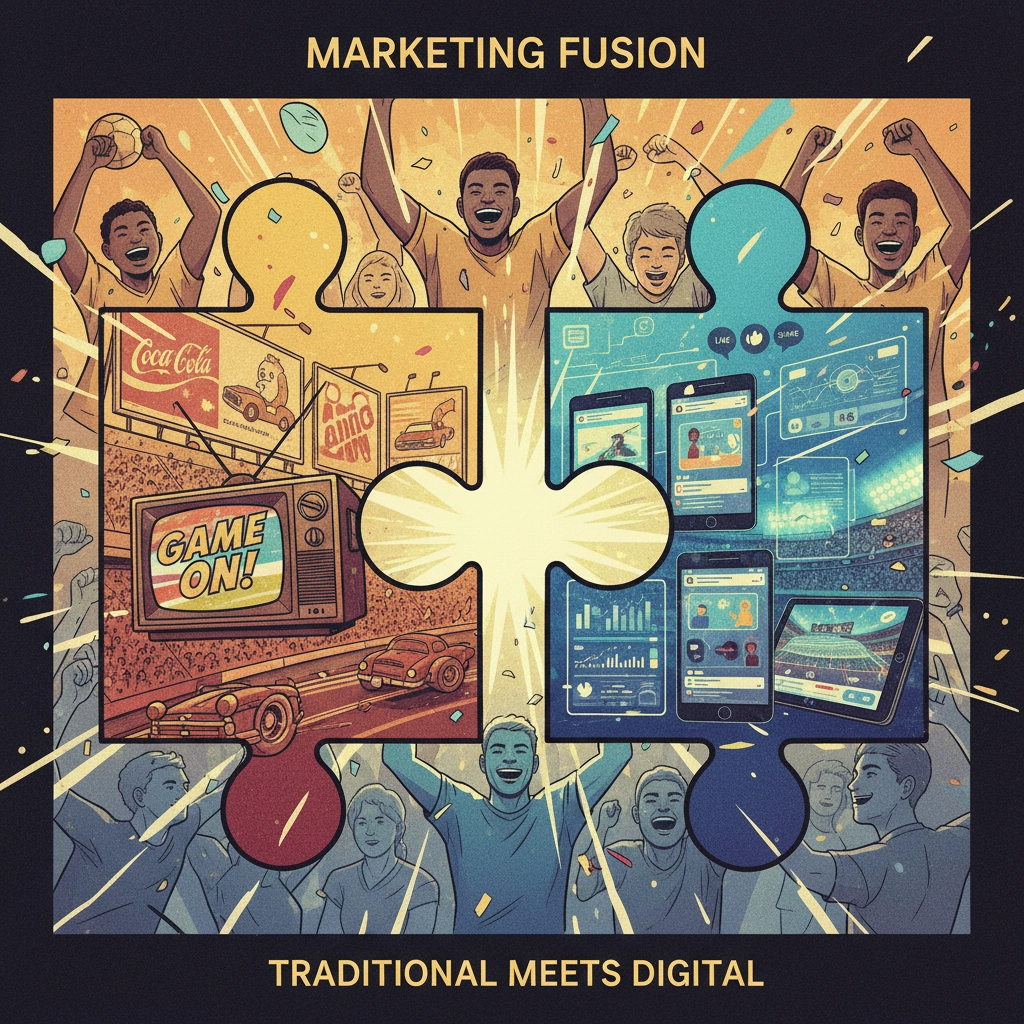The sports marketing landscape has shifted dramatically over the past few years. While traditional billboards, TV commercials, and radio spots haven't completely disappeared, they're no longer enough to capture and keep fan attention. The question isn't whether traditional marketing is dead: it's whether you're adapting fast enough to stay relevant.
The Reality Check: What's Actually Changed
Sports fans today expect more than passive consumption. They want interactive experiences, behind-the-scenes access, and genuine connections with their favorite teams and athletes. The old playbook of throwing money at expensive TV ads and hoping for the best simply doesn't cut it anymore.
Traditional sports marketing relied heavily on one-way communication. Teams and brands would broadcast messages through TV, radio, and print media, hoping to reach as many eyeballs as possible. The approach was broad, generic, and measured primarily by reach and impressions.

Today's successful sports marketing is built on engagement, personalization, and community building. Fans don't just want to watch: they want to participate, predict, compete, and connect with others who share their passion.
What's Actually Working in 2025
Gamification Takes Center Stage
The gamification market is projected to reach $30.7 billion by 2025, and sports organizations are leading the charge. Teams are transforming passive spectators into active participants through fantasy leagues, prediction games, and loyalty programs that reward consistent engagement.
Take the NBA's approach with their mobile app. Fans can predict game outcomes, participate in live trivia during timeouts, and earn points that unlock exclusive content or merchandise discounts. This strategy keeps fans engaged throughout entire games, not just during commercial breaks.
Data-Driven Personalization
Modern sports marketing leverages massive amounts of fan data to deliver tailored experiences. MLB, NBA, and NFL teams partner with analytics companies to understand individual fan behavior and preferences.
Consider how Fanatics uses browsing history and team preferences to recommend specific jerseys and memorabilia. Or how Under Armour analyzes fitness tracker data to create personalized training plans and product recommendations for amateur athletes.
This level of personalization was impossible with traditional marketing methods. Radio ads couldn't adapt to individual listeners, and TV commercials couldn't change based on viewer preferences.
Social Platform Evolution

Social media platforms have evolved far beyond simple photo sharing and status updates. Each platform now offers unique features that smart sports marketers are leveraging:
TikTok has become the go-to platform for behind-the-scenes content. Professional teams share locker room moments, training sessions, and player personalities in ways that traditional media never could. The algorithm rewards authentic, engaging content over polished advertisements.
Instagram continues to dominate with Stories, Reels, and live streaming capabilities. Teams use Instagram to provide real-time game updates, player interviews, and exclusive access to events.
Twitter/X remains essential for real-time conversations, breaking news, and fan interactions during live games. The platform's new features allow for enhanced engagement through polls, Spaces, and community building tools.
YouTube has evolved into a comprehensive content hub where teams create documentary-style content, player profiles, and analysis shows that rival traditional sports programming.
The Rise of Niche Communities
Traditional marketing cast wide nets hoping to catch anyone interested in sports. Modern marketing recognizes that sports fans are incredibly diverse and passionate about specific teams, players, or even statistical categories.
Reddit forums, Discord servers, and Facebook Groups have become spaces where fans create deep connections around shared interests. Successful brands now participate in these communities authentically rather than treating them as advertising targets.
Platform-Specific Strategies That Work
Fanz and Next-Generation Social Platforms
Newer platforms like Fanz are designed specifically for sports fan engagement. These platforms understand that sports fans want more than general social media: they want sports-focused communities, real-time game discussions, and connections with other passionate fans.

These specialized platforms offer features traditional social media can't match: game-specific chat rooms, fantasy league integration, and tools designed for sports discussions and analysis.
Immersive Technology Integration
Virtual reality and augmented reality have moved beyond novelty into practical marketing tools. Teams offer virtual stadium tours for fans who can't attend games in person. AR filters allow fans to virtually try on team merchandise or take photos with their favorite players.
These technologies create memorable experiences that traditional marketing simply cannot replicate. A TV commercial about team spirit can't compare to a VR experience that lets fans virtually walk onto the field with their favorite players.
Livestreaming and Real-Time Content
Livestreaming has revolutionized how teams connect with fans. Beyond traditional game broadcasts, teams now stream practice sessions, player interviews, and behind-the-scenes content that provides unprecedented access.
This approach builds stronger emotional connections between fans and teams. When fans feel they have inside access and special knowledge, their loyalty and engagement increase significantly.
The Hybrid Approach: Blending Old and New
The most successful sports marketing strategies in 2025 don't completely abandon traditional methods: they integrate them strategically with modern digital approaches.
Stadium experiences remain powerful for reaching core fans directly. However, these in-person experiences now connect to digital platforms, social media communities, and personalized follow-up campaigns to maximize impact.

A fan might see a billboard for their favorite team, then scan a QR code that takes them to an exclusive mobile experience with team content, exclusive offers, and connection to other fans. The billboard serves as an entry point to a comprehensive digital ecosystem rather than a standalone message.
Measuring Success in the New Landscape
Traditional sports marketing measured success through reach, impressions, and brand awareness surveys. Modern sports marketing focuses on engagement metrics, community growth, and conversion rates.
Successful campaigns now track metrics like:
- Fan engagement rates across platforms
- Community growth and retention
- User-generated content volume
- Direct revenue attribution from digital campaigns
- Long-term fan lifetime value
What This Means for Sports Organizations
Sports teams, leagues, and related brands must adapt their marketing strategies to meet evolved fan expectations. This doesn't mean abandoning all traditional methods, but it does mean fundamentally rethinking how to connect with audiences.
The organizations thriving in 2025 recognize that fans want:
- Personalized experiences based on their specific interests
- Interactive participation rather than passive consumption
- Authentic connections with teams and other fans
- Access to exclusive content and behind-the-scenes moments
- Integration between digital and physical experiences

The Path Forward
Traditional sports marketing strategies aren't dead, but they're no longer sufficient as standalone approaches. The winners in 2025 are organizations that successfully blend the human connection of traditional marketing with the scalability, personalization, and engagement capabilities of modern digital platforms.
Success requires understanding that today's sports fans are active participants, not passive consumers. They want to be part of the story, not just observe it from the sidelines. The brands and teams that recognize this shift and adapt their strategies accordingly will build stronger, more engaged fan communities that drive long-term success.
The question isn't whether you should abandon traditional marketing entirely: it's whether you're ready to evolve your approach to meet fans where they are and how they want to engage in 2025.
